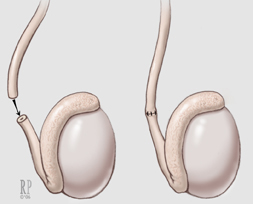 Scientific Editor: Editorial Board ISUD website
Scientific Editor: Editorial Board ISUD website
What is Vasovasostomy?
Vasovasostomy is the anastomosis of vasa deferentia (the main ducts through which semen is carried from testes and epididymis to the ejaculatory duct). It is the surgical procedure to connect the vas deferens to the vas deferens.
When is it performed?
The most common indication for vasovasostomy in our country is obstructive azoospermia, that is when the vasa deferentia are obstructed and sperms in a man’s semen cannot pass through, usually after some infection. In this case, the therapist physician removes the obstructed part and reconnects the two ends of vas deferens. Vasovasostomy is also performed when there are traumatic or iatrogenic vasal injuries. In addition, Vasovasostomy is conducted in men who have undergone vasectomy in the past but who now want to reverse it because they have decided they want to have children. Vasectomy is a surgical procedure providing male contraception by ligating (tying) vasa deferentia in order to prevent sperm from entering into the ejaculate. This method is very common in the U.S.A., but not in Greece.
What sort of preparation is required?
Preoperative preparation includes the standard preoperative control, i.e. blood tests and chest X-ray. The patient has to follow the basic preoperative instructions, that is not to smoke, eat or drink anything for 8 hours before surgery. In case of patients with chronic diseases, therapist physicians have to ensure that their patients are well controlled before reaching the operation room.
How is the procedure performed?
The procedure requires general or ,more rarely, spinal anesthesia. Depending on the case, an incision is made high in the scrotum or the groin. That is where the cut ends of vasa deferentia are located and reconnected. Before the procedure, the therapist physician has somehow to confirm that the patient produces sperms. This is confirmed when the patient has already fathered or when having a normal spermiogram that was carried out before vasectomy. Otherwise, the therapist physician may recommend testicular biopsy, sperm storage and cryopreservation, before doing the anastomosis.
The average hospital stay is 1 day.
What about after the procedure?
Upon discharge from hospital, you will receive specific instructions about:
- when it is safe to restart your anticoagulant therapy
- when it is safe to resume to intense physical activity and work
- what antibiotic regimen to take
- how to take care of your wound
What is the effect on patient’s quality of life?
Most patients face no problem after undergoing vasovasostomy. It usually takes 5-6 days for the wound to fully heal. Also, it may take one week for the patient to fully recover and resume to normal life. The patient may resume to a typical office work within 1-2 days after surgery.


